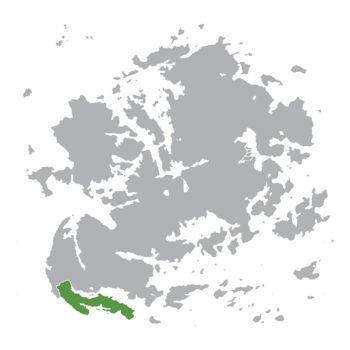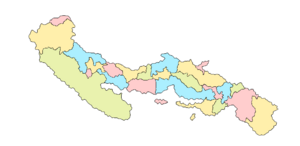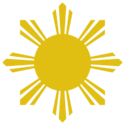Ashanga
This article is incomplete because it is pending further input from participants, or it is a work-in-progress by one author. Please comment on this article's talk page to share your input, comments and questions. Note: To contribute to this article, you may need to seek help from the author(s) of this page. |
Federal Republic of Ashanga Federaalawaa Riippabiliika Ashanga (Ashangi) | |
|---|---|
| Motto: "Faith and Unity" | |
| Anthem: "With God, For Ashanga" | |
 Location of Ashanga in Azania | |
| Capital and largest city | Nechi |
| Official languages | Ashangi |
| Recognised regional languages | Nokwari, Aduani, Nantu |
| Ethnic groups | |
| Religion |
|
| Demonym(s) | Ashangi |
| Government | Federal parliamentary republic |
| Kobby Okese | |
| Akasi Baako | |
| Legislature | Parliament |
| Gola Gosootaa | |
| Gola Ummataa | |
| Establishment | |
| c. 950 | |
| 1268 | |
| 1927 | |
| 1963 | |
| 1998 | |
| Area | |
• Total | 1,003,579 km2 (387,484 sq mi) |
| Population | |
• Q4 2023 estimate | |
• Density | 8.92/km2 (23.1/sq mi) |
| GDP (nominal) | 2023 estimate |
• Total | 2.62 trillion ₵ (38.47 billion AD$) |
• Per capita | 292,919 ₵ (4,295 AD$) |
| Gini (2022) | medium |
| HDI (2022) | medium |
| Currency | Cedi (₵) (AHC) |
| Time zone | UTC+5 (WET) UTC+6 (TMT) |
| Driving side | right |
Ashanga, officially the Federal Republic of Ashanga is a country located in the Azania region of Europa on Eurth.
History
Antiquity
The relative isolation of the tribes and chiefdoms of the Ashangi lands were slowly drawing to a close when Christian missionaries began to enter the area and spread the teachings of God. Christianization drew the Ashangi people closer to the rest of Europa and the subsistence villages began a gradual transformation to towns, cities and small kingdoms. The Wotena dynasty would establish themselves as the most powerful family in Ashanga and would govern the people thanks to the support of other powerful families. Ashanga was known as Wotena in other lands, thanks to the ruling dynasty, while Ashangi people themselves identified as such.
Wotena Period
- Church cemented its power
- Land expansion to the whole peninsula
- Autonomy granted to local chiefs in turn for loyalty (tradition of local rule, "Bilisummaa")
- Nechi made Crown Capital
Early modern period
- Increased internal fracturing
- Religious differences become pronounced
- Noble privileges are set in law to maintain order
Orinese connections
- Orinese expedition to eastern Ashanga, establishes trade forts (later abandoned)
- Crown seeks greater trade, influx of gold, spices, ivory and other luxuries (see Pearl Road)
- Rise of Ashangi pirates near trade routes
Modernization attempts
- Attempts at industrialization, modern government reforms
- Fails due to noble privileges, civil war almost happens 4 times
- Rise of socialist and nationalist groups
National Republic
The Kingdom would come crashing down in 1937, as socialist suppression and social upheaval came to a boiling point in the Revolution of 1937. A multitude of factors caused the revolution, increasing poverty, economic turmoil, political instability and finally the King died without an heir and the powerful families began to squabble for power. It is from this point on the Kingdom of Wotena would be dropped as the international use and the National Republic of Ashanga would become standard instead, Ashanga would have this name from then on, breaking almost 600 years of naming conventions.
Dictatorship of Pinaman
The Revolution would be successful and the following 30 years Ashanga would find itself governed by the increasingly authoritarian National Revolutionary Council under Chairman Adofo Pinaman. The NRC would begin rapid industrialization and modernization initiatives, building much of the infrastructure that still exists today. Pinamans policies of the disenfranchisement of ethnic minorities, civil rights and heavy state oppression would draw much international condemnation.
The Crimson Revolution
The death of Pinaman due to a heart attack in 1958, saw the Chairmanship transfered to deputy Kojo Sowah. Sowahs rule would be short and tumultuous, lacking the gravitas and determination that Pinaman used to assert control, Sowah was stricken with indecision. Economic turmoil was on the horizon and Sowah would drastically cut back on government spending, in everything from Defence and pensions to subsidies for agriculture. The Army and underground resistance movements made contact and the foundation for a Coup d'etat were laid in early 1962. On 25 February 1963, the Crimson Revolution also known as the Democratic Revolution would overthrow Sowah and the National Revolutionary Council and establish a military junta. It is considered the beginning of the Ashangi transition to democracy, which would see the adoption of the First Constitution, under a Federal Republic, in 1963 and the first democratic election in Ashanga would take place in 1964.
Federal Republic
The First Constitution of the Federal Republic of Ashanga, established a federal system of government, with an upper and lower house representing the States and the People respectively. The judiciary was made independent and a Supreme Court was established to oversee that legislation didn't go against the constitution. States were given autonomy and allowed to make their own legislation concerning certain topics, although Federal law could overrule State law if deemed so by the Supreme Court. The President was stripped of legislative power and became a ceremonial figurehead, with the Prime Minister responsible to Parliament. It was a huge step forward from the de-facto junta of Pinaman and opened the door to further political freedoms.
Transition to democracy
The Election of 1964 was, considering the young and fragile system, a very 'normal' election. As the National Democratic Party was formed by many of the people who helped create the Constitution, there was already wide support for the election and the people running for Parliament. That didn't mean corruption wasn't widespread, political opponents clashing in some cities and the integrity of the election being questioned by international observers. However, for a first election for a country emerging out of 20 years of dictatorial rule, the election was a success and the National Democratic Party had gotten a democratic mandate to further reform the country. Up until the turn of the 20th century, the National Democratic Party has been leading the country in a Dominant Party system. They have collaborated, been in coalitions with, and have had opposition from, other parties in Parliament, but they have been in control of key government positions.
21st Century
In 2004, the Republican People’s Party won a majority which allowed it to form a government. The RPP is a socialist democratic party, while the NDP has been a firmly traditional and conservative party, so this was a big deal. The RPP government would expand human rights, political participation and oversaw a reorganization of the Federal structure, with new states centered around the minority groups in the country, getting greater representation. Since 2004 the RPP and NDP have traded power back and forth in a more competitive multi-party system.
Geography
Ashanga has a variety of landscapes, sprawling highlands, dense jungles and endless savannahs. Mixed in with the intricate river system of streams and lakes sits many tiny villages nestled in the nooks and crannies of the interior. The coast is where the major cities and the capital and metropolis of Nechi is located.
Climate

- Tropical köppen climate
- Topography
- Rainfall (affected by monsoon?), mountains, rivers
- Temperature
Biodiversity
- Natural habitats, national parks (savannah tours)
- Wildlife, endangered species
- Pollution, deforestation
Politics
Working as a federal republic, the states within Ashanga has a great deal of autonomy, with the capital in the Nechi Capital District. The federal government and the national parliament has the right to overturn any state decision or legislation, with the President's approval. The President is a mostly ceremonial figure, functioning as a rubber stamp for legislation and affirming ministers brought forth by the Prime Minister, who is head of government. The States and the federal system is based on a legacy of strong local identity and self-rule by the minorities, rights which have been upheld by the Constitution since 1998.
Administrative divisions
Ashanga uses a federal system for its administrative subdivisions with each state is one of 4 types; Federal District, Federal Region, Autonomous Region with the Capital District only used for the capital Nechi.
Foreign relations
- Member of the USA and the AN & Observer in EOS
- Good international image, "Good Neighbor" policy questioned after the eruption of the Grand War
Military
- Army neglected under RPP governments (anti-war politics)
- Conscription ended, lack of volunteers
- Well equipped and several domestic suppliers
Economy
- Newly industrialized country since 1994
- Heading for the middle income trap
- 13.2% under national poverty line (under 150 cedi (2.15 AD$) a day)
- Credit rating is B ("Relatively safe investment, though possible future change may threaten the stability")
- Natural resources and deposit sizes (Enormous, Large, Medium, Small)
- MINERALS: Lithium(E), Copper(L), Silver(L), Limestone(M), Iron(M), Gold(M), Cobalt(S), Tin(S), Bauxite(S), Nickel(S), Platinum(S), Phosphates(S)
- FUELS: Coal(E), Natural Gas(M-S), Petroleum(S)
- Main industries include:
- Mining (large exporter of Lithium, Gold and other metals), metalworking, machinery manufacturing, shipbuilding & repair, chemical production, consumer goods (batteries, furniture, soap, clothing, cigarettes, coffee), agricultural products, tourism, and a growing IT sector
- Vibrant tourism industry, took off in 2010's after a curb on crime made travel safer for tourists
- Mezba is a luxury resort city, with over 4 million visitors in 2022.
- Historical sites, wildlife tours, national parks and beach resorts are other major tourist destinations
Demographics
The Ashangi people are a proud people in a fledgling nation. Christianity and ancient oral tradition live side by side in the people and the trauma of past political struggles shape their determination for a better tomorrow.
The cultural identity of the Ashangi people can be seen on their coinage, showing a mixture of local fauna, christian churches and depictions of oral folktales. Ashangi culture is a melting pot of different ethnic groups, the largest is the Ashangi people making up over 65% of the population. The rest is split between the Nokware, Aduane, Nantuo and Nsuo peoples, along with a multitude of foreign immigrants.
Religion
- Almost 90% have Christianity as their religion
- Traditional religions exist in various highland villages
- Notable Salam minority
- Secularism since 1937
Health
- Universal healthcare for nationals
- Personnel and resource shortages in public healthcare
- ~25% of the population have private healthcare
Education
- Literacy rate is 73.4% (2020)
- Free education up to age 12 (primary/elementary school)
Urbanization
Largest cities in Ashanga
2020 National Census | |||||||||
|---|---|---|---|---|---|---|---|---|---|
| Rank | State | Pop. | |||||||
 Nechi  Dohar |
1 | Nechi | STATE | 1,960,973 |  Gendwa  Mezba | ||||
| 2 | Dohar | STATE | 293,748 | ||||||
| 3 | Gendwa | STATE | 247,562 | ||||||
| 4 | Mezba | STATE | 205,027 | ||||||
| 5 | Teklo | STATE | 164,882 | ||||||
| 6 | Scerscera | STATE | 157,017 | ||||||
| 7 | Kurbele | STATE | 127,492 | ||||||
| 8 | Lekemti | STATE | 97,354 | ||||||
| 9 | Menewe | STATE | 79,894 | ||||||
| 10 | Wolinchiti | STATE | 78,492 | ||||||
Culture
Cinema
- Smaller film scene until streaming services took off
- Indie films have taken off in recent years
- Highest grossing movie is the thriller Ija Abidda (The Eye of Fire)
Cuisine

- Long coastlines mean that seafood (fish, shrimp etc.) are staples
- Stews are traditional foods, known as Makaa (Kapenta makaa, rice makaa etc.)
- Fish, rice, maize, yam, palm oil and various beans are most common
Literature
- Oral tradition, not all stories written down
- Many stories include the protagonist traveling to the Highlands for guidance
- Drama/thriller and religious texts are most widespread
Music
- Traditional instruments are drums and flute
- 2000's saw rise of hiphop and rap in Ashanga
- Most famous musician is the Nsuo rapper, Gooftaa (The Boss), who blends the different languages of Ashanga
Sports
- Football (National Team is widely celebrated)
- Badminton / Tennis
- Several chess world champions




